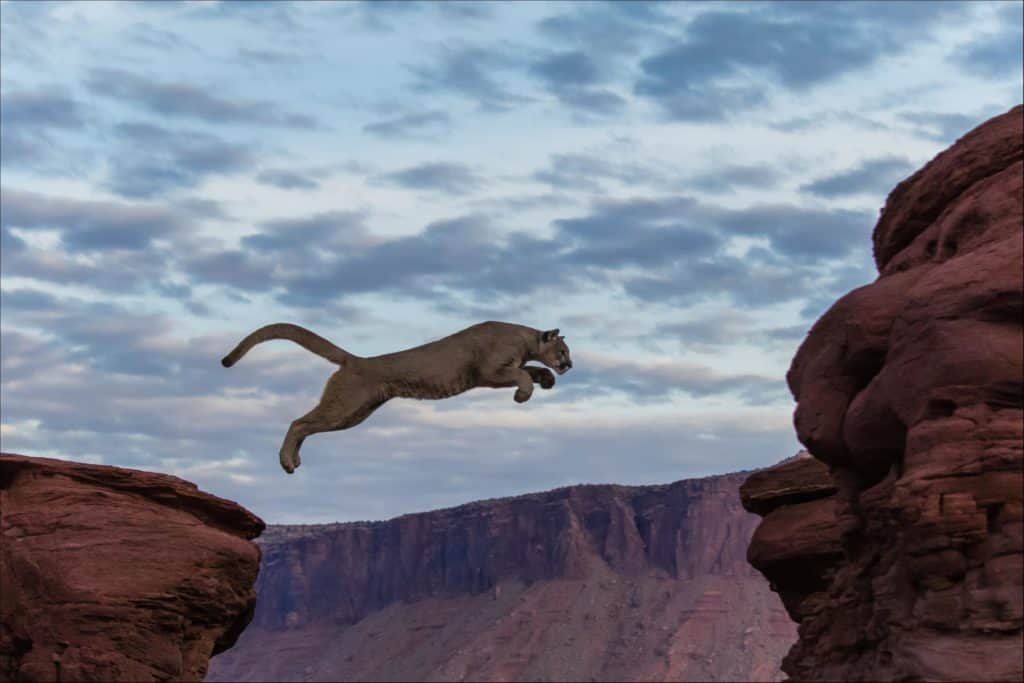California is home to many types of animals. Among these creatures is the mountain lion, the biggest feline to roam North America. These cats are often called cougars or pumas, but a mountain lion by any other name is just as deadly. We’re going to take a look at mountain lions in California and show you what you need to know about these powerful apex predators.
Are Mountain Lions in California?

Mountain lions are found in California and many other states in the U.S.
©Christina Moraes/Shutterstock.com
Yes, mountain lions do live in California. In fact, mountain lions can be found throughout much of the west coast of North America. Their range extends from the British Columbia province of Canada and sinks southward into the westernmost third of the U.S. and Central and South America. Small pockets of mountain lions can be found in eastern areas, too, including Florida!
California is believed to be home to one of the largest populations of mountain lions in the United States. Estimates claim that between 4,000 and 6,000 mountain lions live in California. However, attempting to validate the exact population is difficult. Several hundred mountain lions perished in recent wildfires. Also, some areas are simply too remote for scientists to get an exact count of these incredible predators.
Even with untold thousands of these creatures living amid a densely packed state, mountain lion attacks are relatively rare.
Where Do Mountain Lions Live in California?

Yosemite
National Park
is home to a population of mountain lions
©iStock.com/agaliza
Mountain lions can survive in many habitats as long as they have adequate shelter and food in the area. For example, they thrive in mountainous terrain, forests, deserts, and other places that allow them to hunt prey.
In California, mountain lions can be found in places that have an abundance of deer, one of the many foods that mountain lions eat. So, it should not be a surprise that these animals live in many of the national parks in the state.
For example, mountain lions can be found in Redwood National Park as well as Yosemite National Park in the state. These animals are flourishing in these protected areas.
Mountain lions are most prevalent in the western and eastern areas of the state, mostly avoiding the deserts of the southeast and the populated spaces between Sacramento and Fresno. At least, only a few sightings of the animals exist in those areas.
Even though they do not prefer to interact with humans, that doesn’t mean mountain lions can’t be found in the populated areas in California. For example, a few mountain lions have been known to live in the Greater Los Angeles area.
Why Are Mountain Lions in California Dangerous?

| Size | Weight: 60lbs-190lbs on average, up to 220lb Length: 5ft-8ft Height: 2ft-3ft at the shoulder |
| Speed | – 30-40 mph |
| Defenses | – High speed – Large size – Good senses – Ability to hide and use fur as camouflage |
| Offensive Capabilities | – Powerful biting force of 1311N, over 400 PSI – Moderately powerful jaws – 2-inch-long canines – 2.5-inch claws |
| Predatory Behavior | – Ambush predator that wraps its forelegs around prey and takes them to the ground – Very quiet hunters that stalk potential prey before attacking |
Although it is hard not to be in awe of these large cats if you see one, that feeling should be overridden by a desire to get out of the area. Mountain lions are very dangerous to human beings, and they have killed people in California and throughout North America in recent years.
As you can see from the statistics about mountain lions above, they are not quite as big as most human beings. Nevertheless, they are still capable of using their claws and teeth to inflict a lot of damage on humans. Moreover, they are experts in taking down taller animals. A fully grown mountain lion can easily knock or drag a person to the ground.
The most dangerous aspect of these animals is how easily they can sneak up on human beings. Mountain lions regularly creep up on animals with much better senses than people. These cats can easily stalk and initiate an attack on a human with very little warning and devastating speed.
How Many Mountain Lions Attacks Have Happened in California?

Mountain lion attacks are rare, and few people have died as a result
©Ipatov/Shutterstock.com
California has only recorded 11 confirmed mountain lion attacks in the last 20 years, and only one of those attacks has been fatal. The majority of the attacks in recent years have been against the very young and old, people unable to fight back against the creatures. Over the last 100 years, only 126 attacks, 27 fatal ones, have occurred throughout the United States.
Although mountain lions are very dangerous, they don’t attack humans very often. Simply put, humans are not good prey for them. Humans appear large and don’t act like typical prey, so most mountain lion encounters end with the feline leaving. They’d rather attack prey they know.
Also, these cats tend to live in remote areas where most humans don’t go. However, some factors are beginning to play a role in an uptick in human-mountain lion attacks in the country. Increasing mountain lion populations, more hunting permits being issued to kill the animals, and humans encroaching on remote areas all lead to more attacks.
Hikers, bikers, and hunters should all be aware of the potential to encounter these animals in California.
How to React to Mountain Lions in California

A mountain lion is more likely to attack if you run or crouch
©Kwadrat/Shutterstock.com
Whether you spot a mountain lion in the wild, you need to take precautions to thwart an attack. Use these tips to keep yourself and your family safe.
- Stay calm and don’t make sudden movements.
- Slowly move away from the mountain lion if it has not yet spotted you. Do not run.
- If a mountain lion has spotted you, give it room to escape. These animals often attack when cornered.
- Do not lose sight of the mountain lion.
- Make yourself look bigger by waving your arms or by using your clothes to expand your profile.
- Do not turn away or bend over to pick up anything. That opening will invite the animal to attack.
If the animal starts behaving aggressively, then:
- Yell at the mountain lion in a loud voice.
- Start throwing whatever you have at the animal to make it turn away.
- Prepare to fight if it comes close, protecting your head and neck from the assault.
- Fight back with everything and anything you have if attacked. Use sticks, rocks, pocketknives, or anything else that can be reached without bending over
Afterward, report the incident to local authorities even if the mountain lion flees. The fact that the mountain lion had an encounter with a human is significant.
Mountain lions in California aren’t exactly common, but you can run into one of them. Before you venture into the remote areas of California, you need to learn how to prevent mountain lion attacks. Learning proper camp setups, staying in groups, and keeping children nearby are just a few of the preventive methods that can keep people safe.
The photo featured at the top of this post is © Scott E Read/Shutterstock.com
Thank you for reading! Have some feedback for us? Contact the AZ Animals editorial team.






